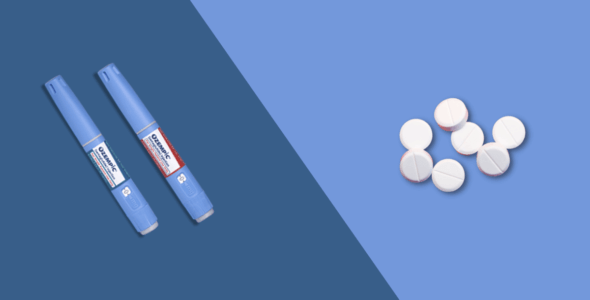Metformin alternatives for diabetes
Metformin is approved by the FDA as a first-line treatment used as part of a treatment plan for diabetes management in people with Type 2 diabetes mellitus. Metformin can be used alone or in combination with other medications. It is also used for the prevention of prediabetes. Diabetic patients are more likely to suffer from other medical conditions like high cholesterol, heart disease, and high blood pressure.
Metformin may also be used for the treatment of polycystic ovary syndrome (PCOS), a condition that affects ovulation and may increase androgen production. Metformin is used in these patients to treat the associated insulin resistance. PCOS increases the risk of developing obesity, depression, infertility, and type 2 diabetes. Metformin has been used to help women with PCOS reduce waist size and help with weight loss. Metformin can also be used for the treatment of metabolic syndrome but is not recommended for the treatment of type 1 diabetes.
Here we will take a look at what metformin is, its benefits and side effects, and the alternatives available.
What are the benefits of metformin?
Metformin reduces blood glucose levels by reducing the production of glucose by the liver, reducing the absorption of glucose in the intestine, and increasing glucose used by adipose tissue and skeletal muscle. Metformin is generally safe and does not tend to cause very low blood sugar or hypoglycemia. Other advantages of metformin include its ability to cause a modest reduction in body weight, and the ease with which it may be used in combination with other medications for blood glucose control.
What are the possible side effects of metformin?
Metformin may not be suitable as a treatment option for everyone. Those who have previously had an allergic reaction of any kind to metformin and any other biguanide should avoid using it. Also, those suffering from severe renal impairment should avoid using metformin, and some patients may not be able to manage some of the gastrointestinal side effects causing them to become non-compliant with this medication. The extended-release form of metformin could help to reduce the undesirable side effects, but not enough to be able to use metformin on a regular basis.
The most common side effects of metformin in clinical trials include:
- Lower blood sugar levels
- Gastrointestinal side effects such as nausea and diarrhea
More serious side effects of metformin include:
- Unusual muscle pain
- Problems breathing
- Dizziness, feeling faint
- Feeling tired
- Stomach pain
- Vomiting
- Slow or irregular heart rate
- Lactic acidosis – symptoms include unusual muscle pain, difficulty breathing, stomach pain, dizziness, feeling cold, or feeling very weak or tired
What are other treatments for diabetes?
Metformin may not be suitable for all patients due to its side effects, or you may not have an adequate response to your metformin treatment. Luckily, there are many other treatments available for the treatment of Type 2 diabetes. These include:
- Precose (acarbose) an alpha-glucosidase inhibitor. Precose blocks the formations of glucose and fructose from sucrose in the small intestine, and also helps to delay the absorption and digestion of carbohydrate. Precose is most effective when you consume a diet that is high in carbohydrates. Precose should be taken when starting your meal. Precose is available as a tablet in doses of 25mg, 50mg, and 100mg
- Januvia (sitagliptin), Tradjenta (linagliptin), Onglyza (saxagliptin) – These are all classed as dipeptidyl peptidase 4 inhibitors (DPP-4 inhibitors). The hormone, glucagon-like peptide 1 (GLP-1) in the gastrointestinal tract facilitates the release of insulin. DPP-4 inhibitors will slow the breakdown of GLP-1 (which would otherwise breakdown quickly) enabling better control of glucose by allowing GLP-1 to act for longer. These drugs have a low risk of causing hypoglycemia. These drugs are taken as oral tablets once daily. They are each available in a range of strengths
- Victoza (liraglutide), Ozempic (semaglutide), Trulicity (dulaglutide), Bydureon Bcise (exenatide), and Tanzeum (albiglutide) are classed as glucagon-like peptide-1 receptor agonists (GLP-1 RAs). These attach to the GLP-1 receptors to simulate GLP-1 in the gut and promote the release of insulin dependent on the presence of glucose. This class of medication slows gastric emptying and reduces your appetite by stopping a rapid increase in your blood glucose levels after a meal. GLP-1 RAs will help to reduce cardiovascular issues including heart failures, heart attacks, and stroke. GLP-1 RAs are administered as an injection and are available in a range of doses. Victoza injection is used once each day. Ozempic,, Bydureon Bcise, and Trulicity are also given as an injection but only once weekly. Doses of these medications are tirated upwards gradually so as to reduce gastrointestinal side effects such as nausea and diaarhea
- Glucotrol XL (glipizide), Amaryl (glimepiride), and Micronase (glyburide) are classed as sulfonylureas. This class of drug stimulates beta-cells in the pancreas to release insulin. Prolonged use of sulfonylureas will also cause the liver to produce less glucose. Sulfonylureas are more likely to cause hypoglycemia than other treatments. These are typically available as oral medications in a variety of doses. Treament normally starts at low doses before breakfast, gradually increased to a higher dose, taken twice each day
- Actos (pioglitazone), Avandia (rosiglitazone) are classed as thiazolidinediones. These attach to receptors in fat cells promoting them to mature and promoting fat to be deposited into peripheral tissues. Insulin sensitivity is also increased by decreasing fat complexes. Weight gain and an increase in fat mass is a common side effect. Thiazolidines are available orally, and taken once or twice each day
What are other alternatives to metformin?
Jardiance (empagliflozin), Invokana (canagliflozin), Farxiga (dapagliflozin) are classed as sodium glucose co-transporter 2 inhibitors (SGLT2). These are used in combination with diet and exercise to help control your blood sugar levels. These will help to remove excess glucose from your body in your urine.
Natural alternatives to metformin
Recommendations for the treatment of diabetics must include lifestyle and diet changes. As well, the American Diabetes Association suggests:
- A weight loss goal of 5%
- Foods in your diet containing unsaturated fats like olive oil and fish
- Reducing your consumption of saturated fats such as butter and bee
- Reducing carbohydrate intake
- Exercise
There are a number of products promoted as natural alternatives to medications such as metformin. These include products such as glucocil, berberine, and insulin. The key thing to be aware of is that these natural supplements have not been tested in the same way for safety or effectiveness as conventional drugs and are not approved by the FDA (Food and Drug Administration). Speak to your primary care professional or healthcare provider for medical advice before using any of these supplements.
Alternatives to metformin for PCOS
PCOS stands for Polycystic ovary syndrome, a condition where a woman may not be able to ovulate, have high androgen levels, or may have small cysts on her ovaries. Symptoms of PCOS may include missed or irregular menstrual periods, infertility, acne, excess hair growth, or weight gain. Insulin-sensitizing drugs are used to treat most women because they have a positive effect on insulin resistance, irregular menstrual periods, obesity, anovulation, and hirsutism.
Your healthcare provider might recommend:
- Combination birth control pills containing estrogen and progestin. Controlling your hormone levels can reduce your risk for endometrial cancer, irregular bleeding, acne, and excess hair growth
- Taking progestin can regulate periods and protect you from endometrial cancer
- Clomiphene, an oral anti-estrogen taken at the start of your menstrual cycle
- Letrozole (Femara) to stimulate the ovaries
- Gonadotropins
Over-the-counter metformin alternatives
As stated previously, there are a number of products promoted as natural alternatives to medications such as metformin. These include products such as berberine, glucocil, and insulin. The key thing to be aware of is that these natural supplements have not been tested in the same way for safety or effectiveness as conventional drugs and are not approved by the FDA (Food and Drug Administration) for the treatment of Type 2 diabetes. Speak to your primary care doctor or healthcare provider for medical advice before using any of these supplements.
What alternatives are there to metformin due to diarrhea?
Alternatives to metformin for the treatment of Type 2 diabetes, that may have a reduced risk of causing diarreah include Prandin, Invokana, Jardiance, and Actos. This list is not exhaustive and other diabetes treatments may also be suitable. It is important to remember that as individuals we are all unique, and not all treatments will cause the same side effects to the same extent with everyone. Always speak to your healthcare provider to discuss which treatment is the best for you.
Is there a better drug for type 2 diabetes than metformin?
Insulin is still the most effective treatment available to reduce blood glucose levels, especially in comparison to oral medicines for type 2.
What is the safest diabetic medication for type 2 diabetes?
Metformin is considered to be the safest medication for Type 2 diabetes. Metformin has been used for many years, is safe and effective. Metformin is recommended as a first-line treatment for type 2 diabetes.
Switching from metformin to an alternative
Speak to your doctor or a healthcare professional if you are considering switching from metformin to an alternative diabetes drugs. Do not stop taking metformin without medical advice from your prescriber. Your doctor will discuss your options that are based on your blood tests and physical state. Suddenly stopping metformin could cause your blood sugar levels to increase rapidly and lead to hyperglycemia (high blood sugar).
You may need to switch to an alternative treatment from metformin if you have ongoing gastrointestinal side effects or kidney disease. Consider if you are prepared to inject meds, the side effects you may experience from other treatments, and how well your blood sugar levels are controlled currently. New treatments will require dose adjustments. Also, be aware that it could take some time to determine which treatment plan is right for you.
Medically reviewed
A medical professional has reviewed this article.


Jamie Winn, PharmD
Jamie Winn, PharmD
Dr. Jamie Winn received his Doctor of Pharmacy in 2002 from the University of South Carolina College of Pharmacy, Columbia, SC. Jamie is a medical reviewer for NiceRx.




